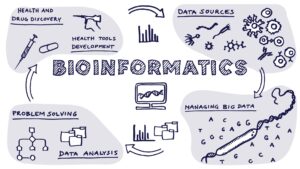Introduction to Bioinformatics
What is bioinformatics?
 Bioinformatics is an interdisciplinary field that combines biology, computer science, mathematics, and statistics to analyze and interpret biological data. In today’s research landscape, advances in genomics, proteomics, and transcriptomics generate massive amounts of data that require computational tools for proper analysis. Bioinformatics helps to uncover patterns and insights from this data, leading to discoveries in areas such as gene function, molecular pathways, and evolutionary biology.
Bioinformatics is an interdisciplinary field that combines biology, computer science, mathematics, and statistics to analyze and interpret biological data. In today’s research landscape, advances in genomics, proteomics, and transcriptomics generate massive amounts of data that require computational tools for proper analysis. Bioinformatics helps to uncover patterns and insights from this data, leading to discoveries in areas such as gene function, molecular pathways, and evolutionary biology.
We leverage bioinformatics to explore complex biological questions. From processing next-generation sequencing (NGS) data to analyzing protein structures, we utilize state-of-the-art tools and develop novel computational methods to enhance our understanding of biological systems. Our research aims to integrate diverse data types, including genomic, transcriptomic, and proteomic data, to drive discoveries in systems biology and precision medicine.
Our core bioinformatics pipeline, the Long Read Proteogenomics Pipeline, uses long read sequence data (from PacBio) to generate a sample-specific database of full-length protein isoforms. It directly incorporates Mass Spectrometry data to detect protein isoforms and confirm translation of transcripts, including the detection of novel protein isoforms.
At UVA, we have access to an internal high performance computing (hpc) system, Rivanna/Afton, which allows us to store, manage, and analyze the large datasets required to gain a comprehensive view of disease predictors in a suite of disease communities.
Cloud computing, like Rivanna/Afton, is crucial for bioinformatics research, as our datasets are large and require computational power that is simply impossible on a local machine. To make our research as accessible to other researchers as possible, we make our pipelines and methods publicly available on GitHub, and our pipelines are also easily incorporated on cloud computing services, such as AWS. Members of our lab are also adept at weilding aritficial intelligence to aid in research pipelines (and perhaps write website blurbs and create images), which is critical for staying up to date in scientific and technological fields!
Image credit DTU Health tech.
How do I get started?
Learning bioinformatic methods can seem intimidating, but anyone can learn! Read about our active research projects using bioinformatics: human disease genetics, proteogenomics, and transcriptomics & long read proteogenomics.
We have some resources on our lab GitHub page, and UVA Health has workshops and tutorials, including for R, python, and version control with GitHub.
The Riffomonas project is an excellent resource for scientists looking to improve their data analysis skills by Pat Schloss from the Department of Microbiology & Immunology at the University of Michigan School of Medicine. Their YouTube page has many step-by-step coding tutorials
